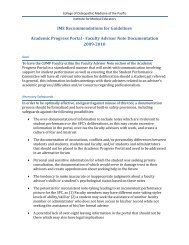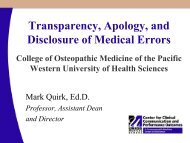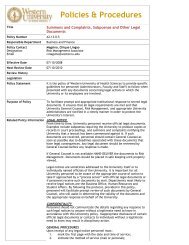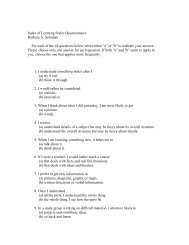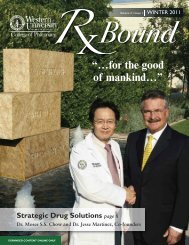Winter 2012 - Western University of Health Sciences
Winter 2012 - Western University of Health Sciences
Winter 2012 - Western University of Health Sciences
Create successful ePaper yourself
Turn your PDF publications into a flip-book with our unique Google optimized e-Paper software.
Anew study published in the New<br />
England Journal <strong>of</strong> Medicine<br />
examines the economic impact and<br />
potential precedent set by the delay<br />
in lipid-lowering drug Lipitor<br />
becoming available in generic form.<br />
Lipitor was the top-selling<br />
prescription medication in the U.S.<br />
in 2010, earning its manufacturer<br />
Pfizer more than $7 billion in total<br />
revenue, according to the study<br />
“Generic Atorvastatin and <strong>Health</strong> Care Costs.” The article’s<br />
lead author is <strong>Western</strong>U College <strong>of</strong> Pharmacy Associate<br />
Pr<strong>of</strong>essor Cynthia Jackevicius, BScPhm, MSc, PharmD,<br />
FCSHP, BCPS (AQ Card). Co-author Mindy Chou, PharmD<br />
’11, is a College <strong>of</strong> Pharmacy alumna who worked with<br />
Jackevicius during her advanced elective rotation.<br />
Lipitor’s patent expired in June 2011, but Pfizer made an<br />
agreement with Ranbaxy, the first company to develop a<br />
generic atorvastatin, to defer the first generic’s introduction<br />
into the U.S. market from June to November. This five-month<br />
delay cost Americans an estimated $324 million in savings.<br />
This cost estimate is very conservative since in the first five<br />
months <strong>of</strong> a first generic, the product price usually only drops<br />
by about 20 percent, Jackevicius said.<br />
Although generic-substitution laws and tiered formularies<br />
have been deployed for years in attempts to promote the use<br />
<strong>of</strong> generic products, patients’ and physicians’ preference for<br />
brand-name medications persists, according to the study.<br />
Examination <strong>of</strong> primary care prescribing patterns with regard<br />
to statins alone reveals that such preferences may result in<br />
$5.8 billion in excess expenditures annually.<br />
Pfizer has employed aggressive business tactics to retain<br />
Lipitor revenue, including strategic agreements with several<br />
prominent pharmacy-benefits management and insurance<br />
companies to provide Lipitor at less than the cost <strong>of</strong> the first<br />
generic atorvastatin, with a generic-level copayment for<br />
patients, in exchange for a monopoly on dispensed<br />
atorvastatin prescriptions, according to the study.<br />
The tactics employed by Pfizer are much broader and allencompassing<br />
that what has been done previously to try to<br />
maintain market share, Jackevicius said.<br />
“Because <strong>of</strong> Pfizer’s aggressive tactics, other companies with<br />
patents about to expire may mimic their actions if they prove<br />
U.S. Statin Market Share before and Projected Market Share after the Entry <strong>of</strong> Generic Atorvastatin.<br />
Data for 2002 through 2009 are from IMS <strong>Health</strong> National Prescription Audit.<br />
to be successful,” Jackevicius said. “There is concern that<br />
some <strong>of</strong> these tactics may delay other generic companies from<br />
making a generic product if they don’t think they will get<br />
much market share after the first six months <strong>of</strong> exclusivity<br />
with the first generic.”<br />
In the short term, a consumer may not be negatively impacted<br />
financially, especially if they get the brand name product at<br />
less than the generic price. Then this is really a win-win. The<br />
questions arise in terms <strong>of</strong> whether there will be enough<br />
generic competition in the long term to promote enough<br />
competition, Jackevicius said.<br />
“Usually about six or seven generic products are needed after<br />
the first six months to drive the generic product price down to<br />
about 20-30 percent <strong>of</strong> the generic, the usual price at that time<br />
with that many generics available,” Jackevicius said. “The<br />
other concern is, who gets the savings from the agreements<br />
with Pfizer to keep using brand name Lipitor? Does the<br />
pharmacy benefits management company or insurance<br />
company give the savings back to the employer, or do they<br />
keep these savings for themselves? If the employer is still<br />
having to pay the higher Lipitor price, then the costs to the<br />
employer, and indirectly to the employee, for the health care<br />
plan is not reduced. It is uncertain, according to the current<br />
agreements that Pfizer has, who retains the savings.”<br />
Whatever happens, Lipitor’s generic transition should be<br />
watched closely, since Pfizer’s strategies may set a new<br />
precedent for the other blockbuster drugs on the verge <strong>of</strong><br />
losing their patents, the study concluded. To read the full<br />
article please visit www.NEJM.org. ■<br />
“Generic Atorvastatin and <strong>Health</strong> Care Costs” (10.1056/NEJMp1113112) was published on<br />
December 7, 2011, at NEJM.org.<br />
<strong>Western</strong>U, College <strong>of</strong> Pharmacy RxBound | 23



